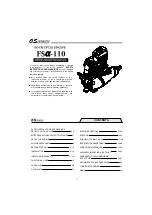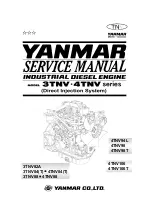
5.13
Section 5
Fuel System and Governor
5
Kohler Emission Sentry
™
System
Some Kohler Command engines are equipped with the
Emission Sentry
™
System. Emission Sentry
™
is a
feature which assures the operator that the exhaust
emission levels of the engine are well within safe
exposure limits. The system does not require any
additional daily maintenance beyond the schedule
normally specified for Command engines.
Principle of Operation
The Emission Sentry
™
System can be broken down
into two functions. One function is to control the ratio
of air and fuel entering the engine. The second
function is treating the exhaust gas, utilizing a 3-way
catalytic converter.
The function of air/fuel ratio control is carried out by an
oxygen sensor placed in the exhaust stream, an
electronic control unit, a stepper motor, and a fuel
metering valve. The oxygen sensor indirectly
measures the oxygen level in the exhaust stream. An
abundance of oxygen indicates a lean condition and a
lack of oxygen indicates a rich condition. The sensor
sends an electrical signal to the electronic control unit
where the signal is analyzed. The electronic control
unit then sends a signal to the stepper motor which
adjusts the fuel metering valve, thus controlling the
amount of fuel entering the engine. The air/fuel ratio is
maintained within a set band under all operating
conditions. By maintaining the air/fuel ratio at peak
performance levels, maximum efficiency is also
realized from the 3-way catalytic converter to further
reduce emissions.
Operating with Emission Sentry
™
The equipment has a 12-volt battery and the engine
has an integral electric starter and charging system.
Starting is accomplished by simply setting the throttle/
choke control and activating the key switch on the
dash panel of the unit. When the engine starts, a
green, light emitting diode (LED) will illuminate, to
indicate that the Emission Sentry
™
is on. It will require
a warm-up period of about sixty seconds to allow the
oxygen sensor to heat up, and the fuel metering valve
to stabilize. When first started, the engine will be
running rich and may sound rough. As the oxygen
sensor heats up and the system stabilizes, however,
operation should become progressively smoother.
After the system has stabilized (about 1 minute),
operation of the equipment can begin.
The oxygen sensor continually monitors the emission
levels in the exhaust while the unit is running. If the
emission levels exceed a predetermined level, a fault
detection circuit will be activated in the electronic
control unit. Once activated, the fault detection circuit
will continue to monitor the signal from the oxygen
sensor for the next 45-60 seconds. If the emission
levels remain at an unsafe level, the fault circuit will
ground the ignition to kill the engine and illuminate a
red LED lamp on the dash panel of the unit. The fault
circuit will reset itself automatically in about 2-3
minutes. If the fault circuit is triggered repeatedly, one
of the components is malfunctioning or faulty, and the
unit should be serviced by an authorized dealer. The
fault circuit will not allow the engine to operate more
than 45-60 seconds with emissions above the
predetermined level.
Troubleshooting the Emission
Sentry
™
System
If the fault circuit is triggered repeatedly during
operation, a fault should be suspected in one of the
following areas:
a. Electrical wires for stepper motor, oxygen sensor,
battery cable, or ground cable have been
disconnected.
b. Stepper motor.
c. Fuel adjusting screw in control valve is binding.
d. Oxygen sensor.
e. Electronic control unit.
If the fault circuit is triggered when the engine is idling:
a. The idle mixture screw on the gas regulator may
be improperly adjusted.
To determine where the fault lies, proceed as follows:
1. Check all electrical connections and leads from
oxygen sensor, stepper motor, electronic control
unit and battery cables. It is best to disconnect
wire connectors from oxygen sensor, stepper
motor and engine functions and check for
corrosion. Reconnect and observe if fault occurs
again.
Summary of Contents for COMMAND CV11
Page 1: ...1 COMMAND SERVICE MANUAL VERTICAL CRANKSHAFT CV11 16 CV460 465 CV490 495...
Page 20: ...2 4 Section 2 Special Tools...
Page 28: ...4 4 Section 4 Air Cleaner and Air Intake System...
Page 54: ...6 6 Section 6 Lubrication System...
Page 109: ...9 15 Section 9 Disassembly 9 Regulating Pin Governor Gear Figure 9 53 Removing Governor Gear...
Page 110: ...9 16 Section 9 Disassembly...
Page 146: ...1 COMMAND SERVICE MANUAL VERTICAL CRANKSHAFT CV11 16 CV460 465 CV490 495...
Page 148: ......
















































